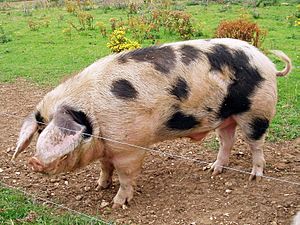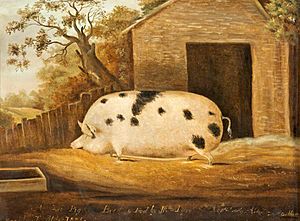Gloucestershire Old Spots facts for kids

A Gloucestershire Old Spots boar
|
|
| Conservation status | Rare breed |
|---|---|
| Other names |
|
| Country of origin | England |
| Traits | |
|
|
The Gloucestershire Old Spots (often called "Old Spots") is a special type of pig from England. It's easy to spot because it's mostly white with clear black spots. This pig breed is named after the county of Gloucestershire where it comes from. Old Spots pigs are known for being calm, smart, and good at having lots of piglets. Male pigs (boars) can grow to weigh about 600 pounds (272 kg). Female pigs (sows) can reach around 500 pounds (227 kg).
These pigs are white with clear black spots. They must have at least one spot on their body to be officially recognized. Old Spots sows are great mothers. They can raise many piglets, even when living outdoors in pastures. Their calm nature and ability to care for themselves make them a good choice for farmers.
Contents
The Story of the Old Spots Pig

The Gloucestershire Old Spots (GOS) pig has a long history. People started a special club for the breed in 1913. They called the pigs "Old Spots" because these spotted pigs had been around for a very long time. Official records for pigs began in 1885. This was much later than for cows, sheep, or horses. Pigs were often seen as animals for farmers, not as important as other livestock.
No other spotted pig breed was officially recorded before 1913. This means the GOS is known as the oldest spotted pig breed in the world. Even though spotted pigs have been in paintings for hundreds of years, the Gloucestershire Old Spots only became an official breed in the early 1900s.
Why This Pig Breed Is Rare
The Gloucestershire Old Spots pig is considered a rare breed. In the United States, it's on a "Critical" list. This means there are fewer than 200 new pigs registered each year. Globally, there are likely fewer than 2,000 of these pigs.
In the United Kingdom, the Old Spots is also rare. It's listed as "Category 5, Minority" by the Rare Breeds Survival Trust. This means there are fewer than 1,000 breeding female pigs registered there.
The meat from Old Spots pigs has a special status in Europe. It's called "Traditional Speciality Guaranteed" (TSG). This means the meat has special qualities. It also means its production methods have been the same for at least 30 years. This helps protect the unique qualities of the meat.
What Makes a GOS Pig Special?
The GOS is a large pig breed. It is white with at least one clear black spot. A key feature is its ears. They are "lop ears," meaning they hang forward. On an adult pig, these ears can almost cover its face.
Here are some things that make a GOS pig a good example of its breed:
- Head: It has a long head with a slightly curved nose. The ears are set wide apart and drop forward towards the nose.
- Body: The shoulders should be smooth. It has a long, flat back with good ribs and a wide loin. The sides should be deep, with a full belly and flank.
- Hams: The back legs (hams) are large and well-filled down to the hock (which is like an ankle).
- Legs: The legs are straight and strong.
- Skin and Coat: The skin should be smooth, not rough or wrinkled. The hair is soft and straight.
- Teats: Female pigs should have at least 14 teats that are well-placed.
Some things are not typical for a GOS pig:
- Ears: Short, thick, or standing-up ears are not good.
- Coat: A swirl of hair (called a "rose") is not allowed. A line of stiff hair on the back is also not good. A sandy color might mean it's not a pure GOS.
- Skin: Very wrinkled skin or blue skin not part of a spot is not good.
- Legs: Curved legs are not good.
- Neck: A very heavy jowl (the fleshy part under the jaw) is not good.
Old Spots Pig Meat
In 2010, the club for Gloucestershire Old Spots pig breeders received a special award. The European Commission gave them "Traditional Speciality Guaranteed" status. This means that meat from purebred Old Spots pigs is special. The club works to make sure that only real GOS pork is sold under this name. This helps protect the breed and its unique meat.

